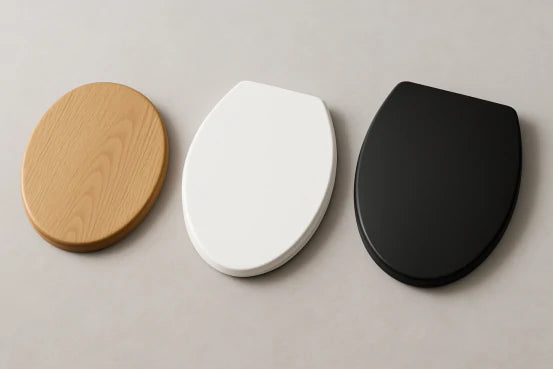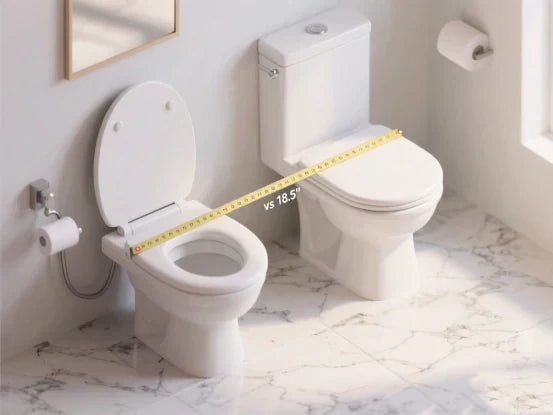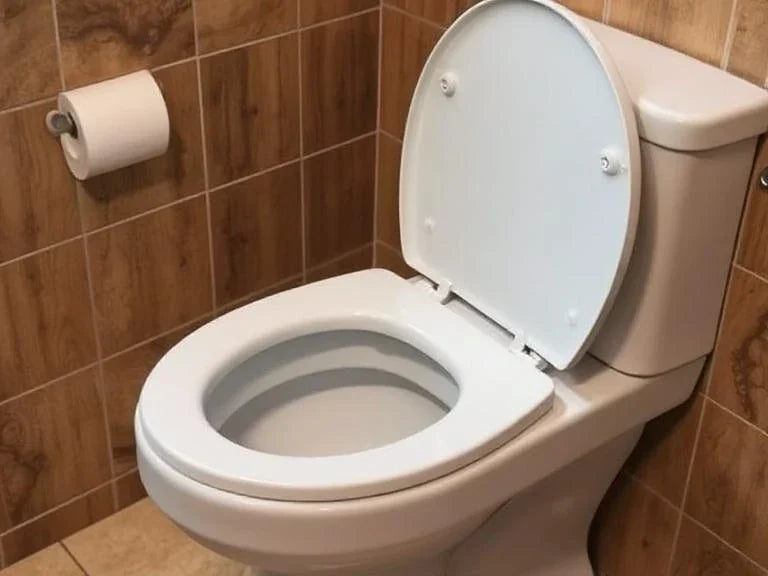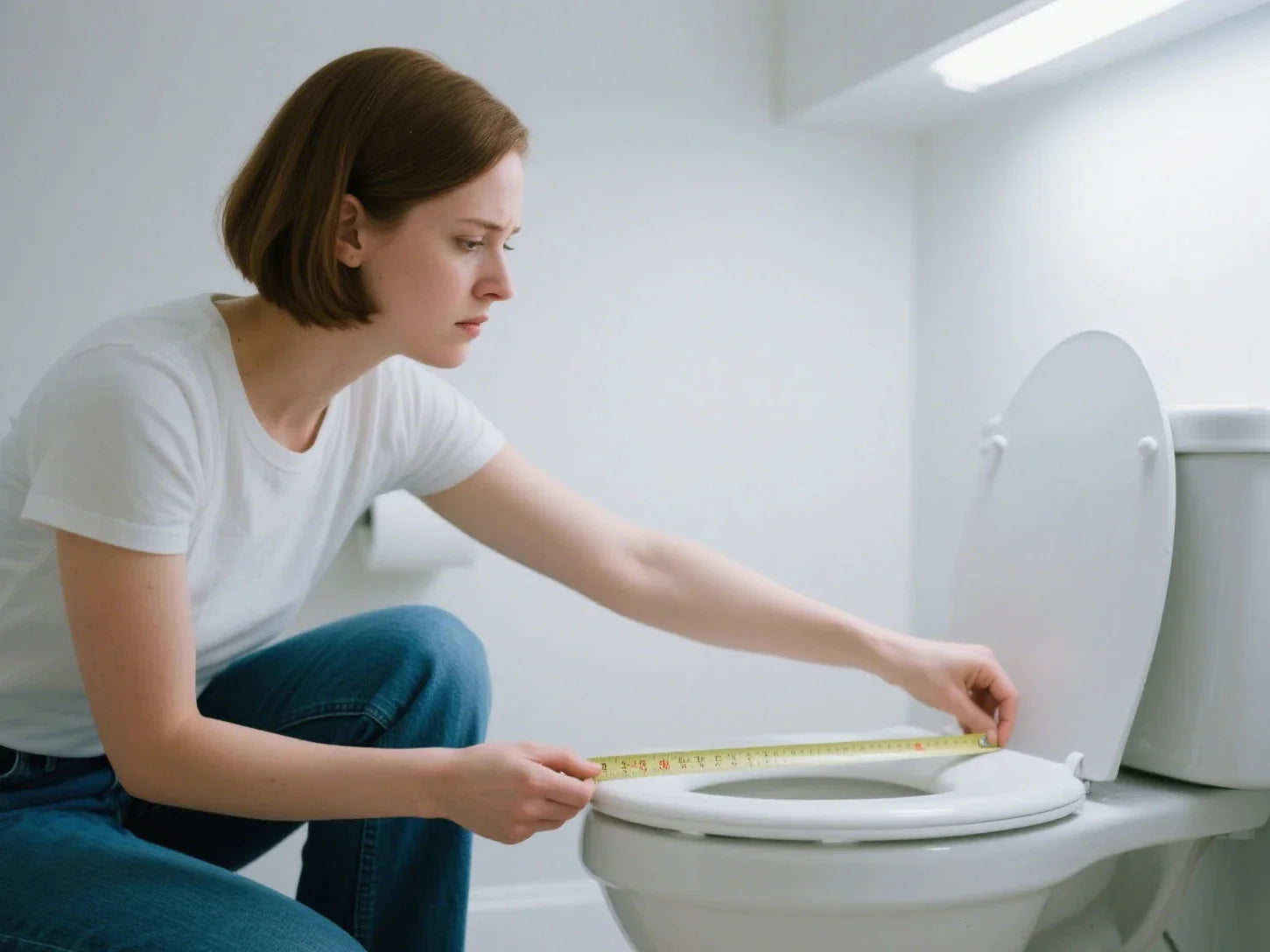Choosing the right toilet seat size is key for comfort, hygiene, and easy installation. Many people are unsure if toilet seats are universal or how to measure for a toilet seat before buying a replacement. In this guide, you’ll learn about the different toilet seat sizes, how to measure your current toilet, and what factors to keep in mind when shopping for a new or replacement seat. We’ll also answer the most common questions, so you never end up with a seat that doesn’t fit.
What Are the Main Toilet Seat Sizes and Shapes?
Most homes have either a round or elongated toilet seat. These two cover the majority of standard toilet seat sizes, but specialty designs are also out there. Understanding the differences sets you up for the right fit.
Types of Toilet Seats

Round Toilet Seat
- Length: About 16.5 inches (42 cm) from the center of the mounting holes to the front edge of the bowl.
- Best for: Older homes, small bathrooms, or compact toilets.
Advantages: Round toilet seats are space-saving and compact, making them ideal for bathrooms with limited room. Their smaller footprint also makes them slightly more affordable and easier to install.
Disadvantages: They offer less seating area, which may not be as comfortable for larger individuals or for those who spend longer periods seated.
Best for:
- Apartments and small powder rooms
- Children or petite individuals
- Homeowners looking for a traditional or vintage style
Elongated Toilet Seat
- Length: About 18.5 inches (47 cm) from the mounting holes to the front edge.
- Best for: Newer homes, people who prefer more sitting space, or users prioritizing comfort.
Advantages: Elongated seats offer a more comfortable seating experience, especially for adults and seniors. They are ergonomically shaped and often preferred in modern bathrooms and public restrooms for hygiene and comfort.
Disadvantages: They require more space than round seats, which may not fit well in tight or awkward bathroom layouts. They also tend to be slightly more expensive.
Best for:
- Master bathrooms or larger spaces
- Seniors and individuals with mobility issues
- Those who value added comfort during use
Specialty & Custom Seats
- Shapes: D-shaped, square, designer contours, or extra-large options
- Sizes: Vary widely; always measure carefully before purchasing
Advantages: These seats are designed to match unique or high-end toilets, often found in luxury bathrooms or European-style fixtures. D-shaped seats provide a sleek, modern look, while square or architectural styles can complement contemporary decor. Some custom seats are also built with bidet functions or soft-closing technology.
Disadvantages: Because of their non-standard shapes, these seats can be harder to replace and often more expensive. Availability might be limited, and installation may require brand-specific fittings.
Best for:
- Modern and designer bathrooms
- European-style or wall-hung toilets
- Users seeking a highly stylized or ergonomic seat solution
- Homeowners looking to match existing luxury fixtures
Standard Toilet Seat Dimensions
| Type | Length (front to bolt holes) | Width (widest point) | Common Use |
|---|---|---|---|
| Round | ~16.5 inches (42 cm) | 14–14.5 inches (35.5–37 cm) | Older or compact toilets |
| Elongated | ~18.5 inches (47 cm) | 14–14.5 inches (35.5–37 cm) | New builds, most modern homes |
| Specialty | Varies | Varies | Designer, public, or custom |
Universal fit? Standard round and elongated seats fit most toilets in the US and UK, but be wary: not all models are interchangeable, especially with imported or custom designs.
How to Measure for the Perfect Toilet Seat Size
Making sure you get the right size is important—the wrong size means the seat won’t fit properly, making the toilet less comfortable and functional. Don’t guess. These easy steps show you how to measure a toilet seat accurately.

A Step-by-Step Guide: Measuring Your Toilet Seat
1. Remove the Existing Toilet Seat
Before taking any measurements, it's important to remove the current seat to ensure accurate access to the bolt holes and bowl dimensions.
- Locate the mounting bolts at the back of the seat, typically covered by plastic caps.
- Use a screwdriver and an adjustable wrench if necessary to unscrew the bolts.
- Lift the seat away and clean the area to expose the full rim and bolt holes.
2. Measure the Bowl Length
The bowl length determines whether you need a round or elongated seat.
- Place the tape measure at the midpoint between the two bolt holes.
- Extend the tape straight to the front-most edge of the toilet bowl.
- Approximately 16.5 inches (42 cm): Suitable for round toilet seats.
- Approximately 18.5 inches (47 cm): Suitable for elongated toilet seats.
Tip: Always measure in a straight line along the bowl’s central axis to avoid underestimating the length.
3. Measure the Width
Width is measured across the widest section of the toilet bowl.
- Place the tape measure at the broadest part of the rim, usually halfway down the sides of the bowl.
- Standard measurements range from 14 to 14.5 inches (35.5 to 37 cm), which works for most round and elongated seats.
Note: If the width is significantly different, you might be dealing with a custom or European toilet design.
4. Measure the Bolt Spread
This is the distance between the two mounting holes at the back of the bowl.
- Measure from the center of the left hole to the center of the right hole.
- Standard bolt spread: 5.5 inches (14 cm) in North America and the UK.
- If the measurement differs, especially in European or older models, you may need a specialty seat or adapter.
5. Check for Odd Shapes or Sizing
Some toilets don’t conform to the typical round or elongated styles.
- D-shaped toilets: Common in modern and European bathrooms, with a flat back and curved front.
- Square or angular bowls: Typically require specialized seats sold by the toilet manufacturer.
- Always use all three measurements—length, width, and bolt spread—for an accurate fit. Photos of the bowl may also help when shopping for an unusual shape.
6. Optional: Measure Seat Height (for Comfort Seats)
If you’re replacing a seat with a comfort-height or padded version, measuring seat height might be useful.
- Measure from the top of the bowl rim to the top of the existing seat when installed.
- Standard toilet seats are around 0.75 to 1 inch (2–2.5 cm) thick, while comfort seats can be up to 2 inches (5 cm) thick.
7. Optional: Consider the Seat Style and Mount Type
Beyond dimensions, some toilet seats offer different mounting methods or aesthetic styles:
- Top-mount vs bottom-mount bolts: Top-mounts are ideal for toilets with concealed or hard-to-reach bottoms.
- Quick-release hinges: Helpful for easier cleaning and maintenance.
- Soft-close lids: Prevent slamming and reduce noise.
- Material options: Plastic, wood, MDF, or cushioned foam each offer different comfort, durability, and visual styles.
| Measurement Point | What to Measure | Typical Size |
| Bowl Length | Bolt holes to front rim | 16.5" (round) / 18.5" (elongated) |
| Bowl Width | Widest part | 14–14.5" |
| Bolt Spread | Center to center, bolt holes | 5.5" |
Tip: Use a flexible tape measure for best results.
Are Toilet Seats Universal?
No, not all toilet seats are universal. While there are several standard toilet seat sizes, the exact width, length, and shape can vary significantly depending on the brand, toilet model, and country of origin. In the U.S., most toilets are either round or elongated, but in Europe and with modern or designer toilets, D-shaped or square bowls are also common. This variation means that a one-size-fits-all approach doesn't always work. If you're planning to replace your toilet seat, it's essential to measure your current toilet carefully. Key dimensions to check include the length from the bolt holes to the front of the bowl, the width at the widest point, and the distance between the two mounting holes (bolt spread). These measurements help ensure you choose a seat that fits securely and comfortably. Overlooking these details may result in purchasing a seat that doesn't align properly, leading to hassle, returns, or discomfort. To avoid these issues, refer to the seat manufacturer’s sizing guide or online tools to compare your measurements and find the perfect match. Taking a few extra minutes to measure can save you time and effort later on.
- Round and elongated are the most common, but custom shapes exist.
- Bolt spread is usually 5.5 inches in the US and UK, but may vary with some models or imported toilets.
- European and Asian toilets might use unique hole spacing; always measure accurately for a good fit.
Comparing Brands, Materials, and Seat Features
When shopping, you’ll notice seats made from different materials and boasting various features. Here’s how to choose the right toilet seat for your needs:
Material Choices

Plastic Toilet Seats
Pros: Plastic seats are the most common and affordable option on the market. They are lightweight, durable, and resistant to moisture, making them ideal for humid bathroom environments. Plastic is also easy to clean and generally does not stain or absorb odors. Many plastic seats are available with quick-release or soft-close hinges for added convenience.
Cons: While durable, plastic seats can feel cold to the touch, especially in cooler climates. They are also more prone to scratching over time and may develop cracks or discoloration with long-term use, particularly if exposed to harsh cleaning agents or heavy weight.
Wood or MDF Toilet Seats
Pros: Wood and MDF (Medium Density Fiberboard) seats offer a warm, solid feel and often a more upscale, traditional look. They tend to be heavier and more stable, which some users prefer for comfort. They also don’t get as cold as plastic, which is a big plus in colder environments.
Cons: Wood and MDF seats are more susceptible to damage from moisture, especially if the finish wears down. If not sealed properly, they can absorb water and start to warp, crack, or harbor bacteria. They are also typically more expensive and heavier, which may make installation slightly more challenging.
Soft/Foam Cushioned Toilet Seats
Pros: Soft or foam-cushioned seats are designed for maximum comfort, making them a popular choice for individuals with mobility issues or those seeking a softer seating surface. They’re warmer to the touch and can offer a more comfortable experience for extended use.
Cons: These seats are generally less durable than solid plastic or wood. The cushioning can break down over time, especially with frequent use, leading to sagging or tearing. They’re also more difficult to clean thoroughly and may absorb odors or moisture, which can lead to hygiene concerns. Additionally, their softer surface can be punctured or damaged more easily.
| Material | Pros | Cons | Common Use |
| Plastic | Lightweight, easy to clean, low cost | Less sturdy, can scratch | Most standard homes |
| Wood or MDF | Warm, sturdy, classic look | Heavier, may chip/wear | Classic homes |
| Soft/foam cushioned | Comfortable to sit on | Not as durable, harder to clean | Kids, medical use |
Features Checklist
- Quick-release hinges: Easy cleaning and removal
- Slow-close lids: Prevents noisy slamming
- Antimicrobial coatings: Extra hygiene
- Lighted seats: Useful at night
Note: Most standard and specialty seats come in both round and elongated options. Always check that the features suit your needs.
Specialty and Custom Toilet Seat Sizes
Some toilets, especially in designer bathrooms or public buildings, might have these specialty toilet seats:
- D-shaped seats: Modern look, often seen in European-style WCs.
- Square or rectangular seats: Often a feature of upscale homes or unique bathroom designs.
- Open-front seats: Found in many public toilets for hygiene.
- Children or trainer seats: Smaller size, softer or fun-shaped for potty training.
Always measure the length, width, and bolt spread. If one area is different, the seat might not fit your bowl even if you think you've picked the right shape.
Example: Measuring a D-Shaped Toilet Seat
- Remove the old seat to see the full rim and bolt holes.
- Measure: From the bolt holes to the very front (length).
- Measure Width: At widest point.
- Bolt Spread: Center to center, as usual.
Some D-shape or designer models may provide their own sizing guides—double-check before you buy.
How to Find Out What Toilet Seat You Need
- Check your measurements: Have the length, width, and bolt spread on hand.
- Look at your toilet's shape: Is it round, elongated, D-shape, or something else?
- Compare your measurements to product size guides. Most packages or sites will list the measurements their seats will fit.
- Need a new seat for a unique toilet model? Contact the maker or check their website for tips on finding the right size.
Quick Facts Table
| Feature | Round | Elongated | Specialty/Custom |
| Typical Length | ~16.5" (42 cm) | ~18.5" (47 cm) | Varies |
| Typical Width | 14–14.5" (35.5–37 cm) | 14–14.5" (35.5–37 cm) | Varies |
| Bolt Spread (US) | 5.5" (14 cm) | 5.5" (14 cm) | May vary |
| Where Common | Compact/old toilets | New builds, comfort | Unique homes, public, overseas |
Pro tip: Over 70% of new homes in North America use elongated toilets for extra comfort and accessibility.
Conclusion: Make Toilet Seat Sizing Easy
Finding the right toilet seat size may seem trivial at first, but it plays a crucial role in both comfort and functionality. A seat that’s too small or doesn’t align properly can cause discomfort, shifting, or even damage to your toilet over time. Thankfully, identifying the correct size is simple—all it takes is a tape measure and a few minutes of your time. Start by measuring the length of your toilet bowl from the center of the bolt holes to the very front edge of the bowl. Next, measure the width at the widest point, and finally, check the bolt spread—the distance between the two mounting holes, which is typically about 5.5 inches in standard US toilets.
Once you have these measurements, keep them noted somewhere accessible, especially if you plan to move, remodel, or upgrade your bathroom fixtures in the future. Having these numbers on hand helps you avoid mismatches, unnecessary returns, and the frustration of installing a seat that doesn’t quite fit. It’s also worth noting that not all toilet seats are created equal—some toilets, especially imported or high-end models, may have custom dimensions or unique shapes like D-shaped or square bowls. In such cases, comparing exact measurements against product specifications becomes even more critical.
Before committing to a purchase, consider using a toilet seat measurement guide or online calculator. These tools help you double-check compatibility and reduce the risk of errors. Some manufacturers even offer fit charts based on popular toilet models. Taking these extra steps ensures that you not only choose a seat that fits properly but also one that complements the style and ergonomics of your bathroom. Don’t leave fit to chance—measure, compare, and make a well-informed choice. The result is a seamless installation and long-lasting comfort every time you use your bathroom.
Toilet Seat Sizes: FAQs
1. What are the sizes of toilet seats?
The market offers two primary toilet seat dimensions which include round and elongated. The front edge of round toilet seats extends 16.5 inches from their mounting holes while elongated seats reach 18.5 inches. The two sizes match the toilet configurations found in most North American homes. The market includes D-shaped and square toilet designs as well as high-end and designer models that use non-standard dimensions. Check the dimensions before buying to confirm proper fit.
2. Are all toilet seats one size fits all (universal)?
The toilet seat does not exist as a universal product. The majority of toilet seats work with standard round or elongated bowls yet there are some exceptions. The design of toilet seats depends on the type of toilet including older models and imported versions and wall-mounted toilets and designer toilets with unique shapes. The bolt spacing which measures 5.5 inches in the US and the bowl contour variations between different toilets affect both the seat fit and user comfort. You must measure your toilet to ensure both the seat shape and bolt spread match before choosing a replacement seat.
3. How do I know if I need a 10-inch or 12-inch seat?
The 10-inch or 12-inch reference typically indicates the rough-in measurement of the toilet which measures the distance from the wall to the floor drain rather than the seat size. The toilet seat size depends on the bowl shape (round, elongated, or specialty) and the distance between the mounting bolt holes (usually 5.5 inches center-to-center in standard US models). To find the correct seat, ignore the rough-in and focus on measuring your bowl length, width, and bolt spacing.
4. How to measure a D-shaped toilet seat?
The first step to measure a D-shaped toilet seat requires removing the current seat for precise measurement. Measure the distance from bolt holes to the bowl front edge and the bowl width at its widest point and the bolt spread which represents the distance between mounting holes. The D-shaped seat design features a flat or slightly curved back and rounded front so you must compare your toilet measurements to the exact dimensions of the D-shaped seat product which can be found on packaging or manufacturer websites.
5. How do I find out what toilet seat I need?
Begin by determining the shape of your toilet bowl which can be round, elongated, D-shaped or square. Measure three essential dimensions after removing the current seat: the distance from bolt holes to the front of the bowl and the bowl's widest width and the bolt holes' distance apart (bolt spread). Standard US toilets typically have bolt spreads measuring 5.5 inches. Check the replacement seat measurements against your toilet dimensions to select a seat that matches both the bowl shape and bolt hole spacing. Check your toilet's brand and model number which appears inside the tank or bowl for compatible seat options if you are unsure.








Leave a comment
This site is protected by hCaptcha and the hCaptcha Privacy Policy and Terms of Service apply.